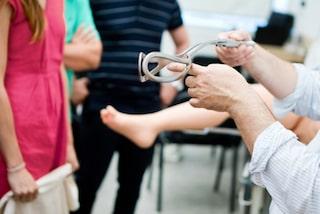Chicago, IL 60601
FREE CONSULTATIONS 312-462-4200
TOLL FREE 833-462-4200
What Is Erb’s Palsy, and How Can it Be Caused by Birth Injuries?

There are a wide variety of complications that can occur during a child’s birth, and if these are not addressed correctly, children may suffer birth injuries. Depending on the type and severity of an injury, a child may require extensive medical treatment or may even suffer permanent disabilities. Erb’s palsy, which is a condition that affects a person’s arms and shoulders, can result from complications during delivery. When a child suffers from this type of injury, parents will want to understand how they can provide the necessary treatment throughout the child’s lifetime.
Causes and Effects of Erb’s Palsy
Erb’s palsy may occur due to injuries to the brachial plexus during a child’s delivery. The brachial plexus is the network of nerves that carry signals from the brain and spinal cord to the shoulders, arms, and hands. These nerves may be injured if shoulder dystocia occurs during birth, especially in cases where too much force is placed on a child’s head, neck, or shoulders. Improper use of forceps or vacuum extraction can lead to nerve damage, and a child may also experience injuries to the brachial plexus during a Cesarean delivery.
The severity of Erb’s palsy will depend on the type of nerve injury experienced by a child. These injuries may include:
-
Neurapraxia - Nerves may become stretched without actually tearing or suffering serious damage. These types of injuries are often relatively mild, and they will often heal on their own within three months.
-
Neuroma - The stretching of nerves may lead to permanent damage, including scar tissue that may put pressure on healthy tissue, inhibiting signals and affecting sensation and muscle movement.
-
Rupture - If a nerve stretches to the point that it tears or becomes severed, this may result in partial or total paralysis, and surgery may be necessary to repair the damage.
-
Avulsion - Nerves may tear away from the spinal cord, which may result in complete loss of function in the arm. This type of injury typically cannot be repaired, although some procedures may be able to restore some function.
Erb’s palsy may cause weakness, numbness, or loss of feeling in one arm, and a child may have a limited range of motion. In more severe cases, an arm may be partially or totally paralyzed.
Mild cases of Erb’s palsy may be treated through physical therapy that can help a child improve his or her range of motion. However, if this treatment is not effective, or if more serious nerve damage has occurred, surgery may be necessary. Nerve grafts or nerve transfers may help restore some function, or muscle or tendon surgeries may improve a child’s ability to control his or her arm movements.
Contact a Chicago Brachial Plexus Injury Attorney
Erb’s palsy and other brachial plexus injuries will often require multiple years of ongoing treatment, and they can lead to life-long disabilities. If your child has suffered this type of injury during birth, you will want to be sure to understand how you can receive financial assistance that will allow you to provide the treatment he or she needs. At the Birth Injury Law Alliance, we can help you determine the best options for providing care for your child. To arrange a complimentary consultation and case evaluation, contact our Cook County birth injury lawyers by calling 312-462-4200 today.
Sources:
https://orthoinfo.aaos.org/en/diseases--conditions/erbs-palsy-brachial-plexus-birth-palsy
https://www.baptisthealth.com/services/neurology-care/conditions/erbs-palsy
https://www.aanem.org/Patients/Muscle-and-Nerve-Disorders/Erb-s-Palsy





